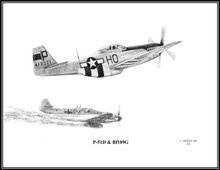 Loading... Please wait...
Loading... Please wait...- Home
- Combat Aircraft/Pencil Drawings ~ Free Shipping
- North American P-51D & Messerschmitt Bf109G ~ Free Shipping
Product Description
Print Size 8½" x 11" ~ Unlimited print edition
One of the most effective and famous fighter aircraft of WWII, the P-51 Mustang, was initially designed to fulfill a British requirement dated April 1940. The most significant variant, the P-51D, featured a Packard Merlin V-1650-7 engine, a 360-degree-view bubble canopy, a modified rear fuselage, and six 12.77-mm machine guns. There were approximately 15,018 P-51s built, 7,956 of which were the P-51D variant. After WWII, the P-51 remained in U.S. service with the Strategic Air Command until 1949, and with the Air National Guard and Reserves into the 1950s. It became one of the first fighters to see combat in the Korean War. The RAF's Fighter Command used them until 1946. In addition, over 50 air forces around the world acquired and used the Mustang for many more years, some as recently as the early 1980s. When the US Air Force realigned their aircraft designations in the 1950s, the Mustang became the F-51.
Warranty Information
null








